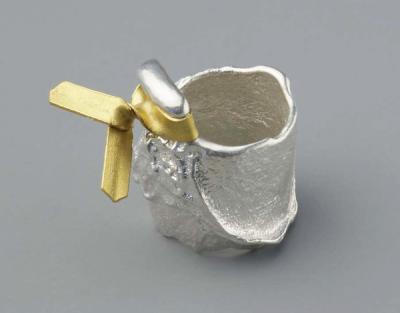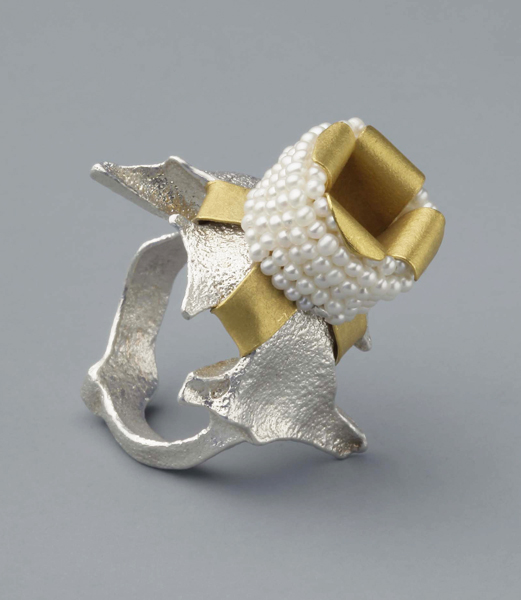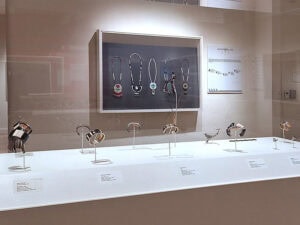
Susan Cummins: You have probably answered this question many times, so I have to request your patience, but you are known for making rings using a casting technique acquired from the African Ashanti and Indian Dokra. Can you please talk about that process?
Johanna Dahm: Compared to other lost-wax casting methods around the world, theirs is unique and genius. Both cultures, living so far apart, not even aware of each other, share a process aptly described as casting in a closed cycle. Yes, the wax model is lost after it has been encased in clay and melted out, yet is still there in its negative. This shell is joined with a layer of clay to the crucible containing the metal, looking like a Babushka. An old oil barrel serves as a furnace, like those of the Ashanti. I love the 1100-degree heat and the smell of glowing bright yellow coal. With long tongs the glowing forms are pulled out of the furnace and merely flipped upside down for casting. This is the closed cycle technique, everything mysteriously hidden to the eye, no separate melting and pouring of the metal. The most exciting part is cracking open the form. Has the piece been cast successfully, or is everything lost? This closed cycle process has great advantage, but as usual only if mastered. Lost and Found: The Ashanti Trail to Rings was thus the title of my first book.

Susan Cummins: You have probably answered this question many times, so I have to request your patience, but you are known for making rings using a casting technique acquired from the African Ashanti and Indian Dokra. Can you please talk about that process?
Johanna Dahm: Compared to other lost-wax casting methods around the world, theirs is unique and genius. Both cultures, living so far apart, not even aware of each other, share a process aptly described as casting in a closed cycle. Yes, the wax model is lost after it has been encased in clay and melted out, yet is still there in its negative. This shell is joined with a layer of clay to the crucible containing the metal, looking like a Babushka. An old oil barrel serves as a furnace, like those of the Ashanti. I love the 1100-degree heat and the smell of glowing bright yellow coal. With long tongs the glowing forms are pulled out of the furnace and merely flipped upside down for casting. This is the closed cycle technique, everything mysteriously hidden to the eye, no separate melting and pouring of the metal. The most exciting part is cracking open the form. Has the piece been cast successfully, or is everything lost? This closed cycle process has great advantage, but as usual only if mastered. Lost and Found: The Ashanti Trail to Rings was thus the title of my first book.
But what interested me was not only applying this technique for my own work, rather taking it a step further. It actually started by coincidence. I had little time, skipped the wax model and formed a cavity directly in the soft clay, a negative form, well hidden, into which the molten fine gold or fine silver later flows. In this process I largely cede the capacity to design to the earth. For me it became an important artistic approach. Cast in this invisible molded void, the jewelry piece becomes the antithesis of the manifestly formed. This emptiness, this nothing, is extremely intriguing and triggers me away from controlled work. The piece can only be guessed and manifests itself when the hammer chatters its clay coat. I named them fast ASHANTI, ‘fast’ meaning ‘nearly’ in German. They are the basis for my new body of work called Enhancement.

Johanna Dahm: I am a child of Apartheid, growing up in Cape Town. Thanks to Max Fröhlich, my teacher at the Art School in Zürich, I heard about this genius Ashanti casting process. As a professor myself, at the Pforzheim University, I had two sabbatical leaves. Yes, going back to Africa and reversing the political role of my youth was also what inspired me to try and be an apprentice of the Ashanti King’s goldsmith. In the Akan society, believing in Voodoo, women are not allowed to even touch the utensils of this technique, only ordained men. This was Nana Poku Amponsah. I finally found him in Kumasi after a long odyssey. For nearly three months was I lucky to be integrated in his everyday life of work and family. It was an extremely happy time. Only towards the end, when none of my casts succeeded, was I in desperate doubt. A Ghanaian librarian calmed me down, saying that if my work had been successful it would have contradicted their traditional beliefs and I must be grateful that only my work and not my health was affected. Nana always answered: ‘Next time better’ and indeed back home my ‘Ashanti’ rings succeeded.
When I learned that the Dokra in India, a total different continent, were casting in the same technique, I packed my baggage and left for my second sabbatical research. This time, more aware of ethnological issues, knowing that the Dokra are illiterate Untouchables and live in very remote areas in Orissa, I was lucky to have Champak Sahu, an Orissan ethnological student as a companion. Three times, staying one month each, we found Dokra casters who generously shared their skills, their modest accommodations and daily rice with us. ‘Stay until you have understood it all,’ said family Rana. ‘Birds of a feather flock together!’ All my rings turned out perfectly; to compare I took the same designs as I made in Ghana. In Jhigidi, a village with 28 casters, I purposely asked Podoma Pidikaka, a female caster if she would be my teacher. In Ghana the work, like collecting and pounding the clay, grinding coal powder etc, was taken from me as much as possible – not with Podoma, she wanted me to do it all by myself, while she watched me. She was unmarried, strong and full of humor, could spit into a bottle from 20 centremeters distance, knew how to cope with jealous male casters, and especially . . . a good teacher.
The similarities to the Ashanti casters are stunning, how is this possible, who started first? Same Same, But Different: The Dokra Trail to Rings, the title of my second book, gives a small insight.

Johanna Dahm: Before I went to Ghana I was struggling with the theme of brooches. They have an obvious picturesque front and a neglected rear side – like the backyard. A brooch needs a pin, also hidden at the back and a fabric where it can attach itself. All attributes which have nothing to do with the sunny side. In my way, I tried to solve this discrepancy by declaring the pin simply as a brooch. The pin, when clamped into the fabric, warps it up and integrates the fabric to an equally important part of the brooch. The human body, touching the skin, is not what the brooch is longing for! But the ring definitely does and is in movement in my own visual field! The casting process in a closed cycle is ideal for rings. Once shattered out of its clay coating it can be fitted immediately over the finger. Perhaps spurs and a casting head have to be removed, but what delight if it can be integrated, no catches, no filing or polishing. Working with soft wax or clay, making heavy rings, pouring fine gold and fine silver, as the metal is found, back into the earthen clay shell is a most sensual process. And rings are sensual. Thanks to my Ghanaian friends did I find my way back to the beauty of precious metals.
This show at Galerie Ra is titled Enhancement. You have in fact enhanced or bejeweled the simple cast rings with rough diamonds, pearls and fine gold. What made you decide to go beyond the minimal forms you have done in the past?
Dozens of fast ASHANTI rings, cast in fine silver, served as exercises for the ones I wanted to cast in fine gold. Most of these practice pieces stimulated me to try new ideas. One knows the feeling when too many things are lying around in the studio and the tiding up starts and then suddenly things seem too precious to dispose of. This is exactly what happened and I gave the rings another chance, turned them to all sides in my fingers and brought them to my working bench for ‘enhancement.’ What they needed was more attention, they wanted to be bejeweled, as you say, wanted to dress up . . . to go out! I added precious materials, trying to emphasis their individual characters and optimize their basic ideas. These enhancing supplements are bound, wrapped, pushed and pulled over and around the fine silver rings. Nothing is soldered or riveted; it can all be stripped off again – a playful game to increase individuality around a millennia-old technique.

Do you know the expression of a person having long roots? They don’t always help; it is a way to cope, especially when one doesn’t know where the homesickness is the strongest. Zürich is my city now and in Holland my family from my mother’s side, but always back to Africa. My favorite teaching place was not my favorite living place, so I commuted to Pforzheim University in Germany for fifteen years. A Swiss proverb describes this as having the five-cent coin and the bun. Accompanying postgraduate students in their four-year studies was a great privilege; I would never have wanted to miss this. Pforzheim is the centre for all possible technical know-how in our jewelry field and a paradise for buying tools and having things made. The jewelry museum, the only museum in the world that is specialized in jewelry, is famous . . . but after work, Zürich is still the best!




